Kentucky Pesticide Safety Education Program

Questions?
Contact
Dr. Ric Bessin
Dept. of Entomology
University of Kentucky
859-257-7450
rbessin@email.uky.edu
Insects
originally prepared by Jim Newman, Extension Forestry Specialist
updated by Jeff Stringer, Extension Forestry Specialist, and Lee Townsend, Extension Entomologist, University of Kentucky
Wood Boring Insects
Bark Beetles
Bark beetles use trees as breeding sites and have an important natural role in killing weak or old trees or aiding the decomposition of dead wood. Odors from damaged trees attract bark beetles so initial attacks in an area often occur on stressed or injured trees. Beetles that develop in these trees emerge through small round holes in the trunk and move to other trees in the area.
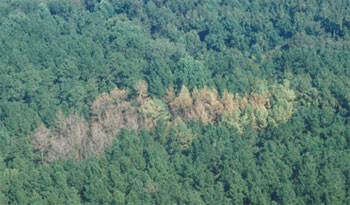
Trees typically die in a directional pattern from
southern pine beetle attack
(Ronald F. Billings, Texas A&M Forest Service, Bugwood.org)
Adults enter trees to lay their eggs, often creating distinctive tunnels or brood chambers. The grub-like larvae bore extensively into the wood feeding on tree tissue or fungi brought to the tree by colonizing individuals. Most bark beetle species in Kentucky attack trees that have been significantly weakened by disease, smog, competition, or physical damage. Extensive tunneling by the larvae can girdle and weaken or eventually kill the tree. Healthy trees have defensive compounds that can kill or injure attacking insects, or simply immobilize and suffocate them with the sticky fluid. However, under outbreak conditions, large numbers of beetles can successfully attack healthy trees with disastrous results for the lumber industry.
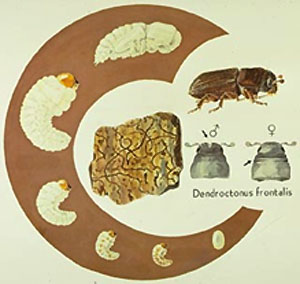
Pine bark beetle life cycle (barkbeetles.org)
Some bark beetles (ambrosia beetles) carry a fungus with them that grows within their galleries in the tree. These bark beetle larvae bore in the tree but feed on the fungal growth. The fungal growth clogs the vascular system of the tree and causes death.
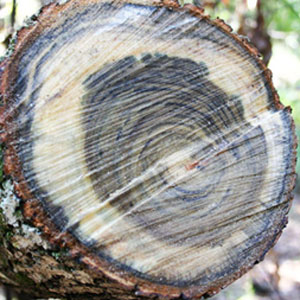
Stained sapwood is an indication of ambrosia beetle attack (entne.dept.ufl.edu)
Good silvicultural practices reduce the potential for bark beetle attack by reducing stress and keeping trees actively growing. When feasible, prompt removal of damaged trees significantly reduces the likelihood of successful bark beetle attacks.
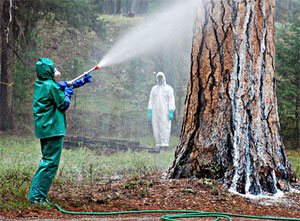
Preventive truck spray to protect against attack by wood boring insects (klyq.com)
Insecticides used in bark beetle control do not penetrate the tree and kill the developing larvae so trees that have been successfully attacked by bark beetles cannot be saved by insecticide applications. However, uninfested high value trees, judged to be at high risk, can be sprayed with an insecticide as a preventative measure against attack. The area of the tree requiring insecticide treatment depends upon the insect species for which the application is being made. The appropriate area of the tree should be thoroughly wetted with the insecticide spray mixture.
Wood Borers
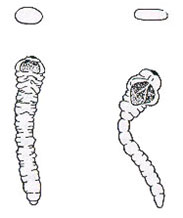
Round headed (left) and flat headed (right) wood borer larvae
(extentopubs.tamu.edu)
Roundheaded and flat headed wood borers are mostly beetles, and a few caterpillars, that infest terminals, shoots, twigs and roots of living trees. Terminal and shoot insects are of particular importance in the initial stages of forest regeneration and early stand growth. These insects are very importance in forest nurseries and ornamental trees. Other species in this category damage or destroy trees that would otherwise produce quality lumber or other wood products. Most insects that cause this damage are borers as adults, larvae, or both.
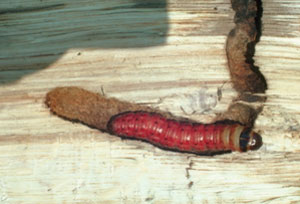
Attack by a carpenterworm, the larva of a moth,
typically begins near a wound.
(James Solomon, USDA Forest Service, Bugwood.org)
As with bark beetles, most borers are secondary invaders that attack bark and wood of trees that are seriously weakened, dying, or recently cut. Examples include carpenterworms, oak clearwing borers, metallic wood borers, and pine sawyers. Trees attacked by these pests are usually scattered so that most control measures are difficult and not economically feasible. Prevention is the best management practice to reduce losses to wood borers. Keeping trees healthy and vigorous will allow them to fight off invading borers.
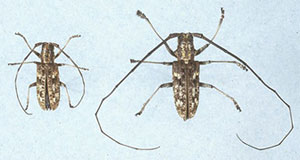
Adult male (left) and female (right) of the pine sawyer, a round headed wood borer (www.apsnet.org)
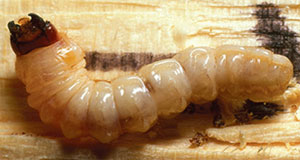
Pine sawyer larva – a round headed borer (northernwoodlands.org)
Pine Sawyer
Pine sawyers develop in fresh cut, felled, dying, or recently dead pines. Young larvae feed on the inner bark, cambium and outer sapwood, forming shallow excavations called surface galleries that they fill with coarse, fibrous borings and frass (insect excrement). They are called "sawyers" because of the noise made while feeding. The beetles can carry the pine wilt nematode.
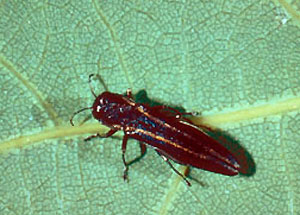
Two-lined chestnut borer adult
(Robert A. Haack, USDA Forest Service, Bugwood.org)
Two-lined Chestnut Borer
The two-lined chestnut borer is a native insect that attacks stressed trees and can hasten their decline and death. Primary hosts are oaks, chestnuts, and beech. When trees and stands are healthy, it attacks low-vigor trees or broken branches. Drought stress and/or defoliation predisposes trees to attack. Outbreaks can occur following severe stress conditions.
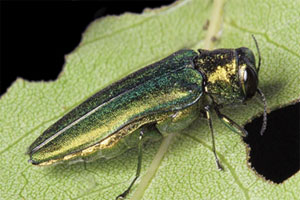
Emerald ash borer adult (www2.ca.uky.edu)
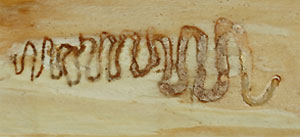
Distinctive serpentine gallery of the emerald ash borer
(David Cappaert, Bugwood.org)
Emerald Ash Borer
The emerald ash borer is a dark metallic green beetle about in color, 1/2 inch in length and 1/16 inch wide, that is May until late July. Larvae are creamy white in color and are found under the bark. The borer's host range is limited to species of ash trees. Usually, they go undetected until the trees show symptoms of infestation – typically the upper third of a tree will die back first, followed by the rest the next year. This is often followed by a large number of shoots or sprouts arising below the dead portions of the trunk. The adult beetles typically make a D-shaped exit hole when they emerge. Tissue produced by the tree in response to larval feeding may also cause vertical splits to occur in the bark. Distinct S-shaped tunnels may also be apparent under the bark.
[return]
Leaf Feeders or Defoliators
This diverse group of insects, which includes many species of caterpillars, sawflies, and beetles, eats leaves and needles. Trees attacked by defoliators can be recognized by missing foliage and uneaten leaf parts such as veins and petioles. Some members of this group feed within a leaf, mining between the upper and lower epidermis. Correct identification of the leaf feeders gives information needed to assess the problem.
Defoliation reduces photosynthesis, interferes with transpiration and translocation within the tree. Light defoliation normally has little effect on the tree but moderate-to-heavy or repeated defoliation can reduce tree vigor. The impact on a tree varies with time of attack, tree species and health, and single or repeated defoliations.
Sawflies
Several species feed on conifers or deciduous trees in forest and plantation stands. The adults are small broad-waisted wasps. Larvae resemble caterpillars but are usually without hairs and have pairs of fleshy prolegs on the underside of every segment on their abdomen (caterpillars normally have four or fewer pairs). Larvae of the more commonly found sawflies vary from 2/3 to 1.25 inches long, are usually greenish to dusky gray, and have conspicuous stripes or spots. Outbreaks occur periodically, sometimes over large areas, and can result in loss of tree growth and sometimes tree mortality.
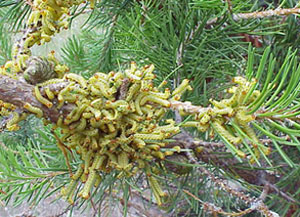
Redheaded pine sawfly larvae (msue.ane.edu)
Redheaded Pine Sawfly
Redheaded pine sawfly has a red head and a yellow-white body marked with six rows of black spots. The larvae are usually found on trees from 1-15 feet tall, where they feed gregariously on old and new needles and on tender shoots of these young trees.
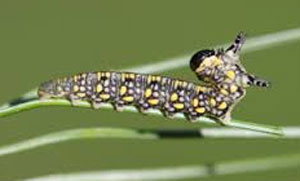
Introduced pine sawfly larva
(Steven Katovich, USDA Forest Service, Bugwood.org)
Introduced pine sawfly has a black head and black body covered with yellow and white spots. The larvae prefer to feed on the needles of eastern white pine but also will eat Scotch, red, Austrian, jack, and Swiss mountain pine. Short leaf and Virginia pines have been attacked but usually are not heavily damaged. Defoliation is most severe in the crown to upper half of the tree but heavily infested trees can be completely defoliated. If this occurs after the winter buds have formed, many branches or even the entire tree can be killed.
There are two generations each year. Larvae of the first generation feed on needles from the previous year. Young sawflies eat the more tender outer parts of the needles while older larvae consume them entirely. They are full-grown (about inch long) in July. The second generation of this sawfly feeds on both old and new needles during August and September. European pine sawfly is a green and black striped larva with a black head. A full grown larva is about 1 inch long. This species can feed on many hosts including Scotch, Eastern white, and Austrian pine. It feeds on the previous year's needles and does not damage new needles.
Caterpillars
Many species of caterpillars feed on deciduous trees in forest and a few feed on conifers. Adults are usually moths but a few are butterflies. Most caterpillars have five pairs of fleshy prolegs - four along the abdomen and one pair at the end. Full grown larvae of the more common caterpillars range from 3/4 inch-long to more than 3 inches. Color and markings are variable. Outbreaks occur periodically, sometimes over large areas, and can result in loss of tree growth and sometimes tree mortality.
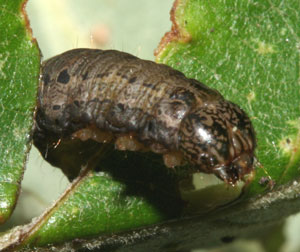
Common oak moth caterpillar
(M. J. Hatfield, bugguide.net)
Common Oak Moth
The Common oak moth caterpillar is brown with tan to black blotches on the sides; there are diamond-shaped markings and slanted lines on its back. This caterpillar moves in a looping manner and is about 1¼ inches long when mature. There is one generation each year with the caterpillars active from May to June. Common oak caterpillars seem to be able to feed on many kinds of oaks but prefer white oaks. In many cases, trees can be severely or completely defoliated. While a single defoliation should not adversely affect established, healthy trees, previous droughts or other stresses can increase the impact of this damage.
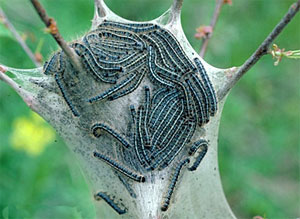
Eastern tent caterpillars
(P. Shrewsbury, University of Maryland, extension.umd.edu)
Eastern Tent Caterpillar
The Eastern tent caterpillar feeds on trees in the genus Prunus; black cherry is the preferred host. The hairy larvae are black with a white stripe down the center of the back. A row of pale blue spots along each side is bordered by yellowish orange lines. Full-grown larvae are about 2 ½ inches long. Defoliated trees normally leaf back out and suffer only minor growth loss.
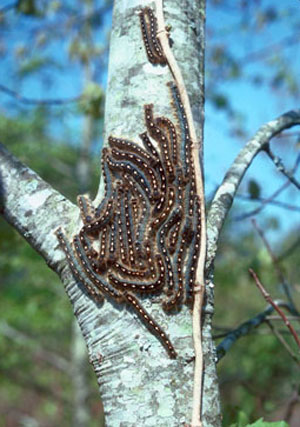
Forest tent caterpillars
(James Solomon, USDA Forest Service, Bugwood.org)
Forest Tent Caterpillar
Forest tent caterpillars are very similar to eastern tent caterpillars but have a row of light keyhole-shaped spots down the center of the back rather than a stripe. They feed on a wide range of trees including sweetgum, oak, birch, ash, maple, elm and basswood. Like the eastern tent caterpillar, there is one generation in the spring.
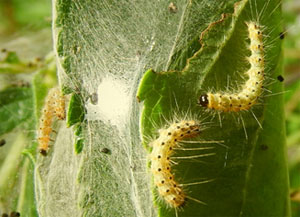
Fall webworm (waldeneffect.org)
Fall Webworm
Fall webworm is a hairy pale green to yellow caterpillar that is about one inch long when full grown. There are two or generations per year. Webworms enclose leaves and small branches in light gray, silken webs. They feed on more than 100 tree species.
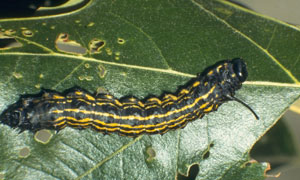
Orangestriped oakworm
(USDA Forest Service-Region8-Southern, USDA Forest Service, Bugwood.org)
Orangestriped Oakworm
Orangestriped oakworm is black with eight narrow yellow stripes along the length of the body. They have a distinctive pair of long, curved "horns" behind the head. They can rapidly strip leaves from small trees but the defoliation usually occurs late in the summer or into the fall, their economic impact is relatively minor.
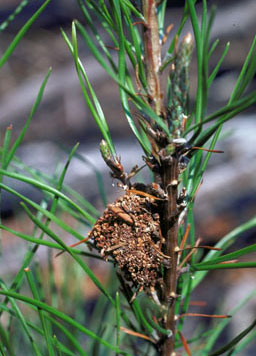
Pine webworm damage
(Robert L. Anderson, USDA Forest Service, Bugwood.org)
Pine Webworm
Pine webworm larvae are yellowish brown with two dark brown longitudinal stripes on each side. Young 12 larvae mine needles, while older larvae live in silken tubes that extend through webs of globular masses of brown, coarse frass. These webbing masses enclose the needles upon which the larvae feed. At first, the webbing masses may be only one or two inches long. The webbing mass may contain several larvae and increases in size as the larvae mature. Seedlings up to two feet tall can be completely defoliated. Infestations on larger trees can cause partial defoliation resulting in loss of growth and poor tree appearance.
[return]
Potential Problem Species
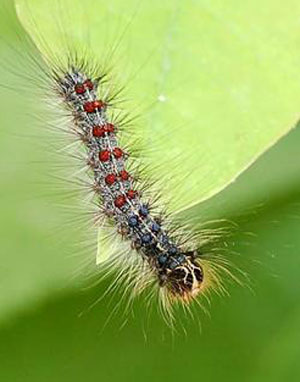
Gypsy moth larva
(Jon Yuschock, Bugwood.org)
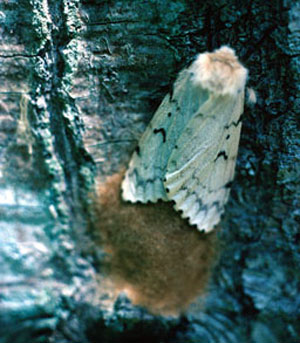
Gypsy moth female with egg mass
(William M. Ciesla, Forest Health Management International, Bugwood.org)
Gypsy Moth
The gypsy moth is established in Ohio, West Virginia, Virginia, and Tennessee. Older larvae have yellow markings on the head, a brownish-gray body with tufts of hair on each segment, and a double row of five pairs of blue spots followed by a double row of six pairs of red spots on the back. Moths are harmless, but the caterpillars from which they develop are voracious leaf feeders of forest, shade, ornamental and fruit trees and shrubs. Large numbers of caterpillars can completely defoliate an area. A single defoliation can kill some softwoods, but it usually takes two or more defoliations to kill hardwoods.
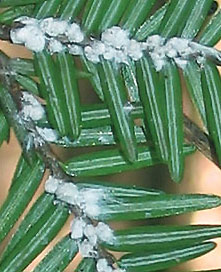
Hemlock woolly adelgid cottony egg sacs (nps.gov)
Hemlock Woolly Adelgid
Established infestations of the hemlock woolly adelgid (HWA) were discovered at specific locations in Harlan, Letcher, and Bell counties in 2006. This native of Asia is a 1/32 inch long reddish purple insect that lives within its own protective coating. White, woolly masses that shelter these sap-feeding insects are at the bases of hemlock needles along infested branches. The presence of these white sacs, which resemble tiny cotton balls, indicate that a tree is infested.
HWA is a threat to eastern hemlock forests, and eastern and Carolina hemlock of all sizes are susceptible. Kentucky has a significant hemlock component throughout its eastern forests, all of which could become infested. In addition, ornamental plantings in urban settings are equally susceptible. HWA feeding reduces new shoot growth, and causes grayish-green foliage, premature needle drop, thinned crowns, branch tip dieback, and eventual tree death.
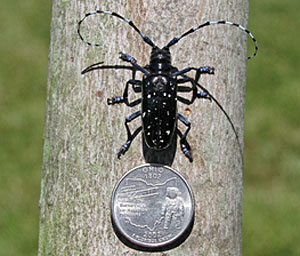
Asian longhorned beetle (J. Boggs, The Ohio State University)
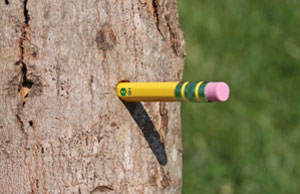
If a pencil can be inserted into an exit hole, it is a good indication that the hole was made by a cerambycid beetle (like the ALB) because the larvae feed deep in the xylem.
(J. Boggs, The Ohio State University)
Asian Longhorned Beetle
Asian longhorned beetle (ALB) is an invasive insect that feeds on a wide variety of trees in the US, eventually killing them. The beetle is native to China and the Korean Peninsula and is in the wood-boring beetle was discovered in Ohio in June 2011. Known hosts include trees in the following genera Ash (Fraxinus), Birch (Betula), Elm (Ulmus), Golden raintree (Koelreuteria), London planetree/ sycamore (Platanus), Maple (Acer), Horsechestnut/buckeye (Aesculus), Katsura (Cercidiphyllum), Mimosa (Albizia), Mountain ash (Sorbus), Poplar (Populus), and Willow (Salix).
[return]
Insecticides for Forest Pest Control
Insecticide applications are rarely practical against forest insect pests. However, they may be useful in specific situations, such as limited infestations of an invasive species. Insecticidal soaps, horticultural oils, Bt- insecticides, and systemics are common choices because they have very low potential to harm the environment, non-target species, and applicators.
Insecticidal soaps are made from of salts of fatty acids. When sprayed directly on vulnerable stages of softbodied insects, such as aphids and adelgids, they kill by damaging individual cells. However, they are not very effective against stages of the life cycle that are inactive or hidden, or against larger insects such as caterpillars and beetles.
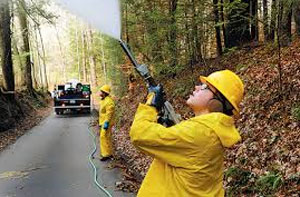
Spraying insecticidal soap to control hemlock woolly adelgid (archive.knoxnews.com)
Insecticidal soap sprays must come into direct contact with the target pest and often results are best against specific life stages. Timing and thorough spray coverage are essential for best results. If the vulnerable stage is active over a long period of time, several applications are needed to control most insects.
Do not apply insecticidal soaps directly to water or use near a water source. Hard water is not effective for mixing soap sprays, so use softened or distilled water for best results. Tender young growth of evergreens and shrubs in the spring can be sensitive to insecticidal soaps. Insecticide applications are rarely practical against forest insect pests. However, they may be useful in specific situations, such as limited infestations of an invasive species. Insecticidal soaps, horticultural oils, Bt-insecticides, and systemics are common choices because they have very low potential to harm the environment, non-target species, and applicators.
Bt insecticides (Bacillus thuringiensis) are protein toxins that are produced by a common soil bacterium. Many provide specific control of caterpillars without affecting other types of insects (beetles, sawflies, etc.). Bt insecticides disrupt the gut wall cells in the caterpillar digestive tract so a formulation of the insecticide must be sprayed on foliage that will be eaten by the caterpillars. Caterpillars stop feeding soon after eating the insecticide but usually do not die for several days. Bt insecticides work best against young caterpillars that are less than half-grown. These insecticides are relatively non-toxic to mammals and other animals.
Imidacloprid is the common name of a systemic insecticide that is used to control sap-feeding insects, such as the hemlock woolly adelgid. It is a nerve poison but it is much more toxic to insects than to warm-blooded animals. Imidacloprid can be diluted in water and applied as a drench poured around the base of a tree, or injected into the soil. The insecticide is taken up by the roots and moved throughout the tree.
[return]
References
Brooks, R. Forest Herbicides and their mode of action. U of Idaho CES Tree Planting and Care No. 15. Forest pest control. U Ga Special Bulletin 16 http://www.bugwood.org/pestcontrol/ Invasive plants of the eastern United States: Identification and Control. http://www.invasive.org/eastern Kentucky Woodlands Magazine Vol 1. SAF.
Herbicide use in forest management - a position of the Society of American Foresters. This publication, originally prepared by Jim Newman, Extension Forestry Specialist, is provided by the Pesticide Safety Education Program of the UK College of Agriculture. This version has been updated by Jeff Stringer, Extension Forestry Specialist, and Lee Townsend, Extension Entomologist.
http://www.ext.colostate.edu/mg/Gardennotes/331.pdf
1) Native bark beetles generally only attack stressed, weakened, or dying trees.
2) Stained sapwood is an indication of attack by ____________.
3) Terminal and shoot insects are of particular importance in the initial stages of forest regeneration and early stand growth.
4) The best means of protecting trees for native boring insects is ________________.
- Preventive insecticide sprays
- Good silvicultural practices to keep trees healthy and vigorous
- Use fungicides to prevent tree-weakening diseases
5) ________________ is an early symptom of emerald ash borer attack.
- Galls on small branches
- Pencil-lead diameter round exit holes in bark
- Die-back of upper third of tree
- Sudden leaf drop over entire tree
6) Light defoliation of trees by caterpillars or sawflies greatly reduces tree vigor and may lead to death.
7) The ____________ is a caterpillar that feeds on more than 100 species of deciduous trees.
photo credits: banner image - Jerry A. Payne, USDA Agricultural Research Service, Bugwood.org
website content by L. Townsend website design by P. Dillon copyright © 2016 University of Kentucky Department of Entomology
University of Kentucky College of Agriculture |
S-225 Agricultural Science Center North, Lexington, KY 40546-0091 | 859.257.7450
An Equal Opportunity University |
Last modified
11/30/2018
